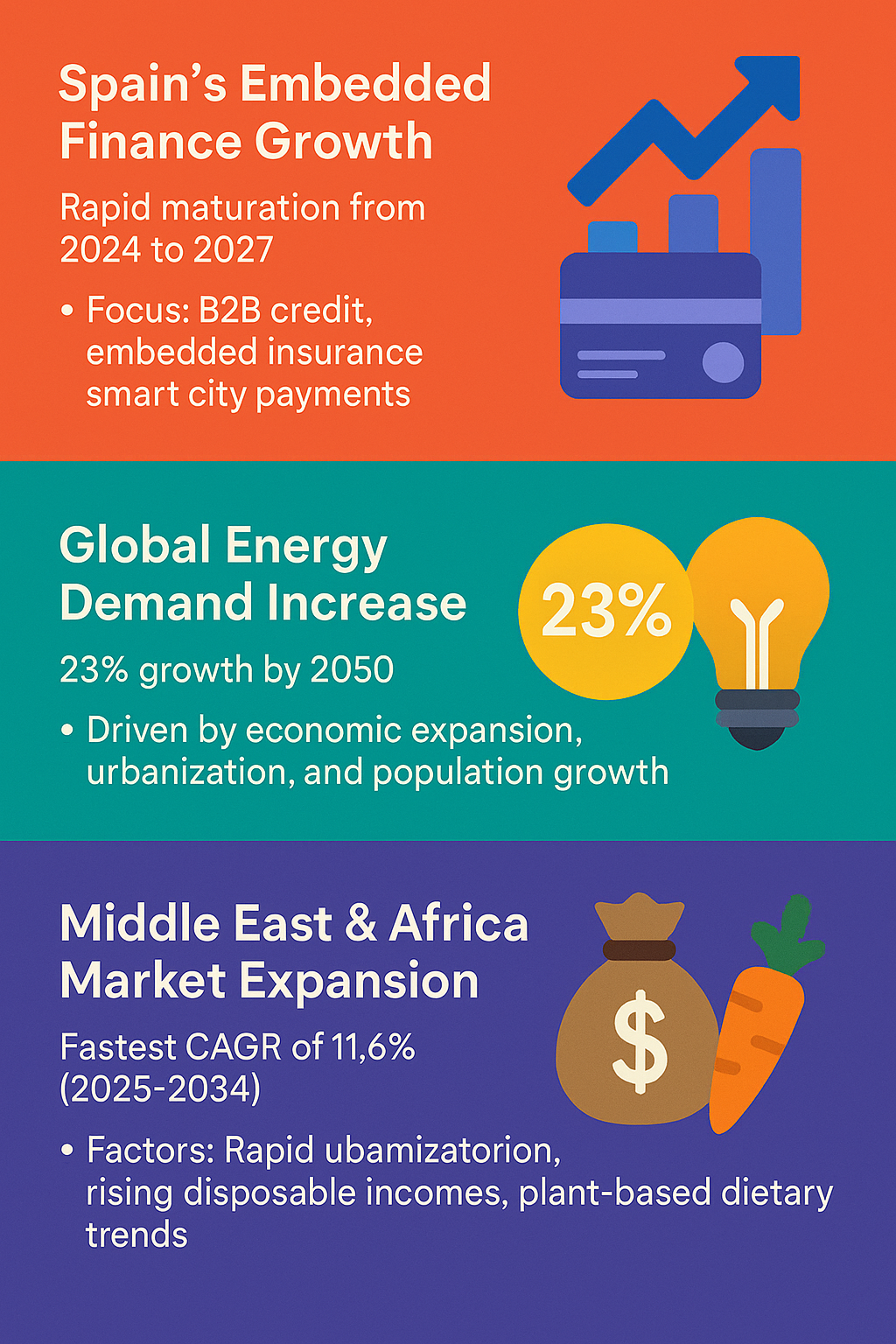Global Scans · Urbanisation & Megacities · Signal Scanner
Embedded Finance in Spain: A Weak Signal Poised to Reshape Financial and Urban Ecosystems
Embedded finance—the integration of financial services into non-financial platforms—is emerging as a discreet but powerful disruptor within Spain’s financial landscape. While embedded finance has steadily gained traction globally, reports indicate a rapid maturation in Spain’s ecosystem over the next 2-4 years, spotlighting niches such as B2B credit, embedded insurance, and smart city payments (Yahoo Finance). This weak signal suggests a future where financial services no longer operate as isolated products but seamlessly interweave with daily commercial operations and urban services, potentially rewriting business models, regulatory approaches, and citizen experiences.
What’s Changing?
The concept of embedded finance goes beyond traditional banking or fintech apps. It involves delivering financial tools—such as lending, insurance, and payment solutions—directly within platforms that are not primarily financial in nature. In Spain, this innovation is projected to accelerate swiftly due to several converging forces.
Firstly, the embedded finance maturity forecast arises amid Spain’s growing digital infrastructure and an increasing appetite for seamless digital transactions in both B2B and B2C environments. Spain’s large SME sector, historically underserved by conventional banking, may increasingly leverage embedded B2B credit offerings integrated into procurement or supply chain platforms (Yahoo Finance). This reflects a broader shift in the financial industry towards more contextualized, on-demand credit.
Secondly, embedded insurance is set to become a focal growth area. Insurance products woven into retail, travel, or automotive services can tailor coverage automatically based on user activity. Imagine, for instance, insurance polices purchasing alongside ride-share trips or e-commerce transactions, enabling granular, just-in-time risk management that simplifies complex insurance buying processes.
Thirdly, smart city payments reflect another dimension of embedded finance evolution. As Spanish urban centers digitize parking, public transport, utilities, and municipal services, integrated payment systems embedded within city apps or platforms could offer frictionless experiences while generating data streams that policymakers and businesses can analyze and act upon in real time.
This trend mirrors global urbanization and digitization patterns, as seen in the Middle East and North Africa’s surging electricity demand impacting urban infrastructure (The National News), as well as Asia-Pacific’s urbanization-driven market expansion (OpenPR).
The convergence of these embedded finance elements with urban digital transformation and economic shifts suggests a layered ecosystem where financial technology becomes indistinguishable from everyday services, potentially elevating operational efficiency and consumer convenience.
Why is This Important?
Spain’s embedded finance trajectory could signal far-reaching impacts across multiple domains. For businesses, embedded B2B credit could democratize access to capital, reducing friction in supply chains and enhancing competitiveness, especially for SMEs traditionally marginalized by mainstream credit systems.
For insurers, embedding insurance products within customer journeys creates deeper engagement opportunities, allowing risk models to become more flexible and data-driven, potentially lowering costs and enabling more personalized policies. This shift could reshape regulatory approaches to consumer protection and risk management.
Municipalities stand to benefit from smart city embedded payments through enhanced revenue collection, greater transparency, and improved citizen services. Integrated payments could streamline everything from parking fees to utilities, fostering more sustainable urban development aligned with citizen behaviors and preferences.
Importantly, embedded finance’s rise carries systemic implications. It could accelerate financial inclusion by bringing credit and insurance to digital-native populations and businesses that conventional financial institutions have struggled to serve efficiently. However, it might also challenge existing frameworks for data privacy, financial regulation, and cybersecurity, demanding adaptive governance.
Implications
The growth of embedded finance in Spain suggests stakeholders should prepare for a more decentralized and service-integrated financial system. Businesses might need to rethink partnerships, considering how to embed financial services into their offerings or leverage embedded finance platforms to streamline operations.
Financial institutions could find their traditional roles challenged or enhanced by collaborating with non-financial platforms, requiring technological agility and regulatory foresight. Insurers and lenders may build new product models optimized for instantaneous, usage-based transactions rather than bulk contracts.
Policymakers and regulators must anticipate how embedded finance changes risk transmissions, consumer protections, and compliance enforcement. Dynamic policy frameworks may be needed to balance innovation with financial stability and data security.
Urban planners and smart city developers should consider embedded payments as foundational infrastructure, integrating financial, service delivery, and urban management systems to optimize operational efficiency and citizen satisfaction.
Strategic foresight teams can monitor the unfolding embedded finance ecosystem by focusing on:
- Accelerated digital adoption in non-financial sectors across Spain
- New regulatory guidelines addressing embedded finance integrations
- Emergence of hybrid business models combining commerce, finance, and urban services
- Data governance and cybersecurity standards adapted for embedded platforms
Taking early steps to partner across sectors or develop embedded finance capabilities may offer competitive edges in efficiency and market reach.
Questions
- Which non-financial platforms in your sector could embed financial services to improve customer experience and operational efficiency?
- How prepared is your organization to integrate embedded finance offerings or collaborate with embedded finance providers?
- What regulatory or compliance challenges could embedded finance introduce for your business, and how can you proactively address them?
- How might smart city embedded payment systems reshape urban service delivery and public-private partnerships in your region?
- What data governance frameworks should be adopted to ensure security and trust in an embedded finance ecosystem?
Keywords
Embedded Finance; Smart City Payments; B2B Credit; Embedded Insurance; Financial Inclusion; Digital Transformation; Urbanization; Regulation; Data Governance; Cybersecurity
Bibliography
- Spain Embedded Finance Report 2025-28: B2B Credit, Embedded Insurance, and Smart City Payments. Yahoo Finance. https://finance.yahoo.com/news/spain-embedded-finance-report-2025-080800194.html
- Electricity Demand Triples in MENA, Straining Infrastructure. The National News. https://www.thenationalnews.com/business/energy/2025/09/18/middle-east-electricity-demand-triples-and-the-strain-is-just-beginning-says-iea/
- Bed Linen Market Growth in Asia-Pacific Driven by Urbanization and Rising Income. OpenPR. https://www.openpr.com/news/4165161/bed-linen-market-to-reach-us-38-2-bn-in-2025-driven-by-rising-home
